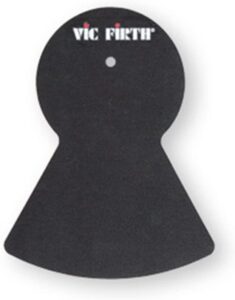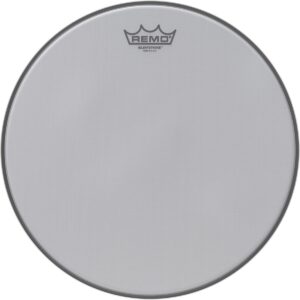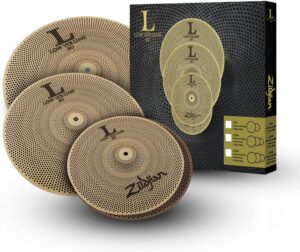I’m sure my parents wished that drum silencing was ‘a thing’ back when I was a kid. When I first began playing drums at around age 5, it was mostly on a practice pad and probably a lot less intrusive to the aural well being of my parents. Fast forward a few years though to my first drum set and I’m sure it was a different story!
By then, I was very much into Nirvana, The Ramones, Metallica and was constantly playing along to those records. Luckily for me, I had very supportive parents that didn’t really seem to mind and also made sure I had plenty of hearing protection to boot.
Case in point, I remember very clearly buying huge blocks of styrofoam with my mom so that I could cut them down to fit my bedroom window. I guess she was tired of the noise complaints from the neighbors and I generally wasn’t a fan of getting the police called out to the house for said disturbance.
The good news for the parents of drummers these days is that it doesn’t have to be like it was back then. A lot of companies make some pretty darn cool drum dampening products to make noise disturbance much less of a factor, while at the same time not sacrificing on quality or responsiveness of the drums themselves. This is key for new students as having products that distort the feeling of the real thing can build some pretty nasty habits.
I’ve pulled some of the more popular solutions into this article with the goal of providing you with the information you need to select a drum set muffling solution that’s best for you. Along with an overview of each product, I’ve also rated them according to the following criteria:
- Quietude – What level of sound reduction can you expect out of these with 1 being ‘Not Much’ and 5 being ‘So Quiet You Could Maybe Get a Nap In’
- Realism/Feel – This rating will give you a sense for how this solution affects the overall performance of the drum itself. A rating of 1 being ‘Detrimental – don’t even think about it’ and a rating of 5 being ‘This is FLAWLESSLY PERFECT!’
- Overall – The overall rating will combine the aforementioned factors, as well as my own personal opinion of the product. The higher the score (on a scale of 5) the better.
So, without further delay, here are some excellent products I would recommend to help with this particular conundrum (pun intended).
Mesh Drum Heads
These drum heads, which are made of a see-through mesh first jumped onto the scene as part of a solution to make electric drum sets feel more like their acoustic counterparts. I’m not sure if they were the first to market with these heads, but Roland V-Drums made these drum heads part of the mainstream.
Playing on mesh heads doesn’t feel much different than playing on regular drum heads, making it just a matter of time before drumhead manufacturers started marketing them specifically for acoustic drums. In other words, very realistic feel with almost no noise. Pretty fantastic in my book. As such, here are my ratings:
- Quietude: 4.5 – They really are SUPER quiet. It’s awesome!
- Realism/Feel: 4 – There really is nothing quite like hitting a read drum with a traditional drum head on it. The mesh heads can be slightly ‘bouncier’ which could be a good thing for some players. It’s definitely not detrimental.
- Overall: 4.5 – It’s a great solution. The only real downside is that it requires you to change drum heads in order to put them on. Ideally, you’d have these heads installed on a practice kit that you leave at home rather than swapping heads out prior to every gig. That said, if you’re not gigging yet…there’s nothing to worry about.
Mesh Drum Head Recommendation:
My go-to here would be the Remo SilentStroke mesh drum heads . Remo is one of the most trusted brands in drum heads and you can’t go wrong with these.
. Remo is one of the most trusted brands in drum heads and you can’t go wrong with these.
Drum Mutes
Unlike mesh heads, drum mutes have been around for quite some time. These mutes are essentially neoprene rubber pads that are placed directly on top of the drum head, held in place by gravity and the drum hoop. This is a fantastic solution because, although they don’t perform quite as well as the mesh heads, the speed factor more than makes up for it. Installation is very fast as you simply place them on top of your drums. Voila! That’s it!
- Quietude: 4.5 – Like the mesh heads, these silencing pads will give you loads of noise reduction.
- Realism/Feel: 3.5 – I never really liked how these mutes felt when I played them, so they are getting a slightly lower score here. The primary issue is that the rebound from these pads is exponentially higher than the actual drum, which takes some getting used to.
- Overall: 4 – As I mentioned, the primary benefit here is the easy & quick installation. I’m not a huge fan of how they feel when played, but it really just depends on what your goals and needs are.
Drum Mute Product Recommendation:
The workhorse of this product category has pretty much always been SoundOff by Evans Drum Mutes . Now owned by Evans, they’ve been around for years and are highly regarded in the industry. While competitors exist out there, the price difference is negligible, so you might as well go with the king of mutes.
. Now owned by Evans, they’ve been around for years and are highly regarded in the industry. While competitors exist out there, the price difference is negligible, so you might as well go with the king of mutes.
Low Volume Cymbals
This is a very recent introduction to the percussion market, but one which I am extremely excited about. Why? Well, they are essentially real cymbals with a ton of holes drilled in them. What does that mean for you? Low volume. Realistic feel.
One of the most prominent cymbal makers, Zildjian claims that their product is 80% quieter without losing any of the feel of traditional cymbals. Well, after having tried a set of these magnificent instruments, I can tell you that their findings seem to be 100% true. It is a lower volume cymbal without compromise.
- Quietude: 4.5 – Given how loud cymbals normally are, the dramatic reduction in volume rates very highly in my books.
- Realism/Feel: 4.5 – They are phenomenally close to playing ‘normal’ cymbals.
- Overall: 4.5 – There have been many attempts to dampen cymbals over the years, including mutes, pads, etc. None have come even remotely close to the effectiveness of these cymbals. The primary reason I haven’t given them a ‘5’ is because for budget-conscious drummers, a new set of cymbals can be cost prohibitive.
Low Volume Cymbal Product Recommendation:
Zildjian is pretty much the only game in town when it comes to this type of product…and they are phenomenal. They call them the L80 Low Volume Cymbals . Available as either single cymbals or in convenient sets, they are well worth the investment for beginners and vets alike.
. Available as either single cymbals or in convenient sets, they are well worth the investment for beginners and vets alike.
Cymbal Mutes
If the aforementioned Low Volume instruments are a bit too rich for your blood, rest assured that there are still some good alternatives out there. Various incarnations of cymbal mutes have been out there for decades, some better than others for sure. The problem with the majority of these mutes is that they consist of wedge-shaped slivers of neoprene (the same material used for the drum mutes) that doesn’t cover the entire cymbal…and also gives each cymbal a very odd should and feel.
I for one, always hated using them because of the feel and also because it was, and still is very easy to miss the mute entirely, causing you to still hit the cymbal itself. Not fun.
Luckily, there have been some recent innovations in the land of cymbal mutes which makes the above much less of a factor. The more modern mutes consist of a cloth or rubber ring which hugs the outside edge of the cymbal and prevents it from excessive vibration. With a mute like this, you’ll still get the decent feel and stick response from the instrument but at a substantially reduced volume. As these are definitely superior products, I’ll base my ratings on the ring-style cymbal dampeners instead of the old-school wedges.
- Quietude: 4 – A fair amount of noise reduction with dramatically reduce sustain.
- Realism/Feel: 4 – They definitely don’t sound natural with the silencers on, however you’ll still get some of the feel elements of a real cymbal
- Overall: 4 – These are great, low-cost alternatives to actual quiet cymbals.
Cymbal Mute Product Recommendations

VicFirth makes a pretty standard and relatively inexpensive Cymbal mute in a variety of sizes to fit most cymbals on the market.
in a variety of sizes to fit most cymbals on the market.
Related Questions
What can I use to dampen my drums?
Any flexible absorptive material will generally work to muffle drums. A lot of drummers use towels, blankets or t-shirts draped over a portion of their drum to reduce the sound. For snare drums, softer wallets tend to be a good way to dampen the ringing of a snare drum.
Why put a towel in a bass drum?
Towels absorb sound and vibration really well and therefore, provide a great solution for not only dampening a bass drum, but also reducing the amount of sustain/ring coming from the drum. The vast majority of musical styles employ some sort of bass drum dampening with the most popular exception being jazz, where a ringing bass drum is typically preferred.
Why do churches put drummers behind glass?
The fiberglass allows for unobstructed viewing of the drummer, while at the same time providing volume control and sound isolation for recording a clean drum sound. These fiberglass baffles isolate the drums to allow for easier mixing and sound reduction in halls (such as churches) which require the sound engineer to control the volume of music more than other typical venues.



